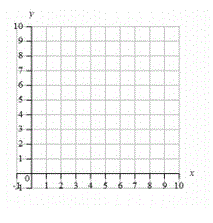4) The coordinates of the vertices of a quadrilateral in
clockwise order are: (0, 3), (4,8), (8,3), and (4, 5).
What is its area?

|
Plot the points on the grid and number them.
Method 1: Cut into triangles and add:
1. Notice that the 2nd and 4th points have the same x coordinate = _____.
2. Cut the quadrilateral into two triangles along this vertical y-line
(4,8) to (4,5)
3. Compute the areas of each triangle and add = ______
|
Method 2: Make a large triangle and subtract the missing triangle:
1. Compute the area of the triangle made by points 1, 2 and 3 = _____
2. Compute the area of the triangle made by points 1, 4 and 3 = _____
3. Subtract the second from the first to get the quadrilateral area = _____
|
|